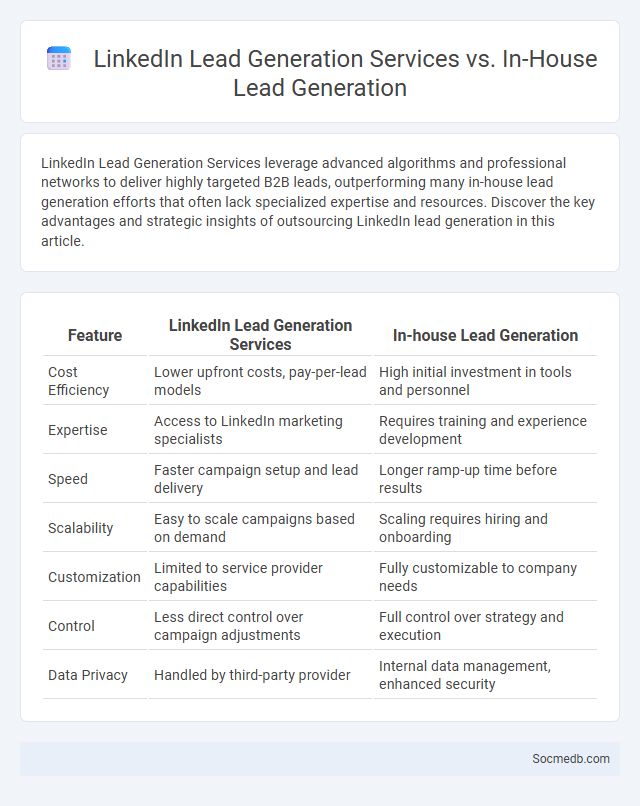
Photo illustration: LinkedIn Lead Generation Services vs In-house Lead Generation
LinkedIn Lead Generation Services leverage advanced algorithms and professional networks to deliver highly targeted B2B leads, outperforming many in-house lead generation efforts that often lack specialized expertise and resources. Discover the key advantages and strategic insights of outsourcing LinkedIn lead generation in this article.
Table of Comparison
| Feature | LinkedIn Lead Generation Services | In-house Lead Generation |
|---|---|---|
| Cost Efficiency | Lower upfront costs, pay-per-lead models | High initial investment in tools and personnel |
| Expertise | Access to LinkedIn marketing specialists | Requires training and experience development |
| Speed | Faster campaign setup and lead delivery | Longer ramp-up time before results |
| Scalability | Easy to scale campaigns based on demand | Scaling requires hiring and onboarding |
| Customization | Limited to service provider capabilities | Fully customizable to company needs |
| Control | Less direct control over campaign adjustments | Full control over strategy and execution |
| Data Privacy | Handled by third-party provider | Internal data management, enhanced security |
Introduction to Lead Generation
Lead generation on social media harnesses platforms like Facebook, Instagram, LinkedIn, and Twitter to attract and convert potential customers by leveraging targeted content and advertising. Utilizing data-driven strategies such as audience segmentation, personalized messaging, and interactive posts increases engagement and captures high-quality leads. Effective lead generation integrates analytics tools to measure campaign performance, optimize reach, and maximize return on investment.
Understanding LinkedIn Lead Generation Services
LinkedIn lead generation services utilize targeted strategies to connect businesses with potential clients by leveraging LinkedIn's vast professional network of over 900 million users. These services optimize your profile, create personalized outreach campaigns, and use advanced analytics to track engagement and conversion rates. You can increase your sales pipeline and foster meaningful connections by harnessing the power of LinkedIn's precise targeting tools and data-driven lead acquisition methods.
What Is In-house Lead Generation?
In-house lead generation refers to the process where your business uses internal resources and teams to attract and capture potential customers through social media platforms like Facebook, Instagram, and LinkedIn. This strategy leverages targeted content creation, paid ads, and organic engagement to build a qualified lead database without relying on external agencies. Maximizing your social media presence for in-house lead generation ensures better control over messaging, data, and results to drive sales growth efficiently.
Traditional Lead Generation: An Overview
Traditional lead generation relies on offline methods such as direct mail, cold calling, trade shows, and networking events to identify potential customers. These time-tested strategies often involve personal interaction and relationship-building, which can result in higher trust and conversion rates. Understanding how your business can integrate traditional lead generation with modern social media tactics may enhance overall marketing effectiveness.
Pros and Cons of LinkedIn Lead Generation Services
LinkedIn lead generation services offer targeted B2B marketing opportunities by leveraging advanced filtering tools and professional networking, significantly increasing the quality of leads and conversion rates. However, the high cost of premium services and the potential for message saturation can reduce overall ROI and limit engagement effectiveness. Businesses must balance investment with personalized outreach strategies to maximize LinkedIn's lead generation potential.
Benefits and Challenges of In-house Lead Generation
In-house lead generation empowers your business with direct control over data quality and targeting strategies, enhancing customer engagement and improving conversion rates. However, it demands significant resources, including skilled personnel and advanced technology, which can strain operational capacity. Balancing these benefits and challenges is critical to optimizing your social media marketing ROI.
Key Differences Between LinkedIn and Traditional Lead Generation
LinkedIn leverages professional networking by targeting decision-makers and industry-specific audiences, enhancing the quality of your leads through detailed profiles and endorsements. Traditional lead generation often relies on broader, less personalized methods such as cold calling or generic email campaigns, resulting in lower conversion rates. Your marketing strategy benefits from LinkedIn's data-driven insights and interaction tracking, which provide measurable and actionable lead generation outcomes.
Cost Comparison: LinkedIn Services vs In-house vs Traditional
Analyzing cost comparison reveals LinkedIn services often present a more scalable and targeted expenditure than maintaining in-house social media teams, which involve salaries, benefits, and training costs. Traditional marketing channels, including print and broadcast, typically incur higher costs without the precise audience segmentation and real-time analytics available on LinkedIn. Investing in LinkedIn's professional networking tools and advertising solutions frequently results in higher ROI due to lower acquisition costs and enhanced lead quality compared to in-house efforts and conventional media.
Choosing the Right Lead Generation Approach for Your Business
Selecting the right lead generation approach for your business on social media depends on clearly defining your target audience and understanding their platform preferences. Utilizing data-driven strategies such as targeted ads, influencer collaborations, and engaging content tailored to user behavior maximizes conversion rates. Constantly analyzing campaign performance metrics ensures optimized lead quality and cost-effectiveness.
Final Verdict: Which Lead Generation Strategy Wins?
Social media lead generation strategies excel through targeted advertising, influencer partnerships, and content marketing, driving higher engagement and conversion rates. Data shows platforms like Facebook and LinkedIn offer advanced targeting tools that significantly boost lead quality and ROI. Choosing the right strategy depends on specific business goals, but integrating paid campaigns with organic engagement consistently delivers the strongest results.
 socmedb.com
socmedb.com